STANDARD USII.4b
The student will demonstrate knowledge of the changing role of the
United States from the late nineteenth century through World War I
by
b) explaining the reasons for the United States involvement in
World War I and its leadership role at the conclusion of the war. |
|
What were the reasons for the United States becoming involved in
World War I?
|
Background
(not in curriculum
guide)
Disagreements in Europe over territory and boundaries, among other
issues, came to a head with the assassination by a Serbian of the
Archduke Ferdinand of Austria on June 28, 1914. War broke out one
month later. Soon Austria-Hungary, Bulgaria, Germany and the Ottoman
Empire were battling the Allied Powers of Britain, France, Russia,
Italy, Belgium, Serbia, Montenegro and Japan.
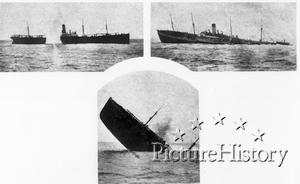
http://www.picturehistory.com/find/p/4351/mcms.html
A German U-boat Torpedoes a Steamer
In these photographs taken around 1916, an Allied
steamer is sunk by U-boat torpedoes. The first major incident
involving a ship carrying American citizens occurred on May 17, 1915
with the sinking of the British ocean liner "Lusitania." Though the
Germans agreed to halt submarine warfare after this incident, they
resumed the practice in early 1917. It was the terrifying, unbridled
attacks of the German U-boats or submarines that finally brought
America into World War I.
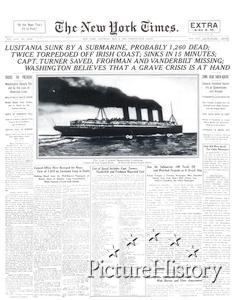
http://www.picturehistory.com
"Lusitania Sunk by A Submarine, Probably 1260 Dead" This
headline from the front page of the May 8, 1915 edition of the "New
York Times"
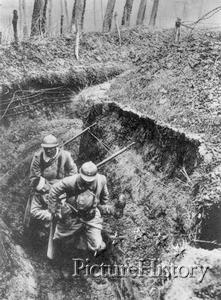
http://www.picturehistory.com
Soldiers Walking Through the Trenches
The endless miles of trenches employed during World
War I were deep, and often fortified with mounded earth and barbed
wire fencing. This photograph shows two men carrying an injured
soldier.
World War I ended June 28, 1919 with the Treaty of Versailles
The Treaty of Versailles imposed very harsh restrictions on Germany,
including limiting its army to 100,000 men. President Wilson, who
opposed the treaty. He prepared his own peace plan called the
"Fourteen Points," which included a provision for a
League of Nations to prevent future wars. German territories
among the Allied Nations. Many historians believe these terms
eventually led to World War II.
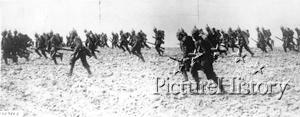
http://www.picturehistory.com/find/p/9315/mcms.html
German Infantry on the Battlefield
German soldiers are shown advancing across a
battlefield during World War I. |
| There were disagreements about the
extent to which the United States should isolate itself from world
affairs. |
| Reasons for U.S. involvement in war
|
Inability to remain neutral
German submarine warfare sinking of Lusitania
U.S. economic and political ties to Great Britain
|
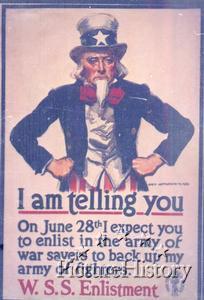 |
http://www.picturehistory.com/
[In response to the government's
calls for enlistments, two million Americans went to France in
1917 and 1918. Their efforts, combined with those of the
French and the British, finally broke the German forces and
led to victory for the Allies]
|
|
The United States involvement in World War I
ended a long tradition of avoiding involvement in European
conflicts and set the stage for the United States to emerge as
a global superpower later in the 20th century.
|
|
Who
were the Allies? |
Who
were the Central Powers? |
|
Allies
Great Britain
France
Russia
Serbia
Belgium |
Central Powers
Germany
Austria-Hungary
Bulgaria
Ottoman Empire (Turkey) |
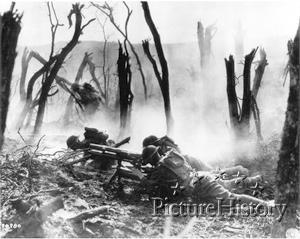
http://www.picturehistory.com
American Gun Crew in Action against Germany --This
photograph from 1918, is of American soldiers making an advance
against Germans in their trenches.
|
|
In what ways did the United States provide leadership at the
conclusion of the war? |
U.S. leadership as the war ended
At the end of World War I, President Woodrow Wilson prepared a
peace plan that called for the formation of the League of Nations, a
peace-keeping organization.
The United States decided not to join the League of Nations.
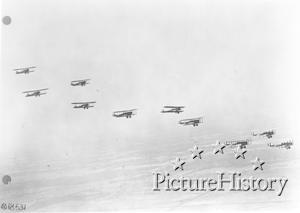 |
|
http://www.picturehistory.com/find/p/7757/mcms.html>
Airplanes Flying in Formation
This photograph provides a view of airplanes flying in formation
during World War I. |
|